Table of Contents
External cladding, a crucial term in the building industry, is integral to enhancing the aesthetic appeal and safeguarding the structural integrity of a building. Over time, cladding is subject to the accumulation of dirt, grime, and weather-related deterioration, making regular cleaning a necessity to prevent moss and algae growth. This article examines the various types of external cladding, the importance of maintaining its cleanliness through regular cleaning, and the numerous benefits it provides. Additionally, a comprehensive step-by-step guide on effectively cleaning cladding is included, along with recommendations for tools and maintenance practices, such as using a soft brush and soapy water, to ensure the cladding's longevity. Dedicating attention to proper care and exterior upkeep can significantly contribute to preserving the beauty and integrity of the building's exterior, ensuring that the protective coating remains intact.
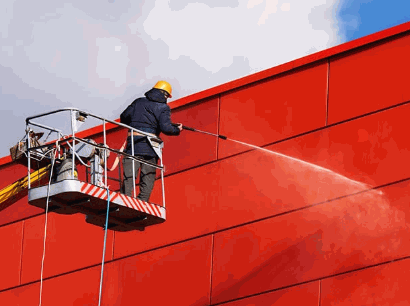
External cladding is a vital component utilized in both residential and commercial buildings, serving as an exterior layer that offers aesthetic appeal and functional benefits such as thermal insulation and a protective coating against various environmental factors.
Available in multiple materials, including composite, timber, PVC, metal, concrete, and stone cladding, it plays a crucial role in enhancing the overall appearance of a structure while safeguarding it from weather damage, dirt, and organic growth like moss and algae.
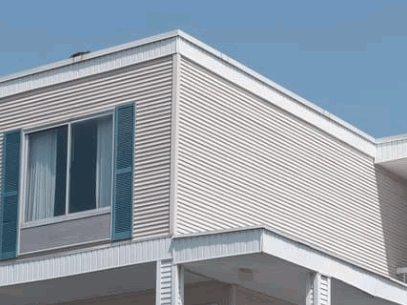
There are several types of external cladding available, each offering unique benefits and aesthetic choices to suit various architectural styles and environmental needs.
Among the most popular options, composite cladding stands out for its remarkable low-maintenance properties, making it ideal for busy homeowners and commercial buildings alike. Its composition typically includes recycled materials, providing an environmentally friendly choice without sacrificing durability.
Meanwhile, timber cladding is favored for its warm, natural appearance, creating inviting facades that work beautifully in residential settings, although it requires regular maintenance to prevent weathering.
On the more modern end, metal cladding offers sleek lines and a contemporary feel, which is often sought after in urban architecture, while concrete cladding delivers unmatched robustness, making it suitable for commercial structures that demand long-term resilience.
Lastly, stone cladding, known for its elegance, enhances aesthetic appeal, making it a preferred choice for luxury developments.
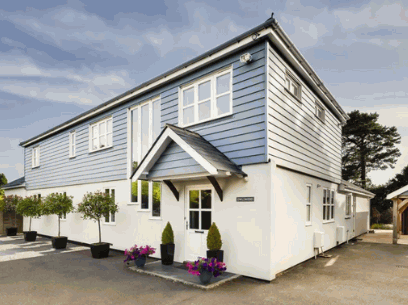
Cleaning external cladding is crucial for maintaining both its appearance and longevity, as neglect can lead to the accumulation of dirt, moss, algae, and even weather damage that can compromise its protective layer.
Regular cleaning not only enhances the aesthetic appeal of a building but also prevents long-term damage and discoloration, ensuring that the cladding remains effective in providing thermal insulation and safeguarding against environmental pollution.
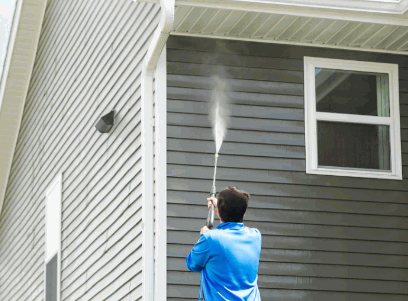
Cleaning external cladding offers numerous benefits, including improved appearance, extended lifespan, and enhanced customer satisfaction, which are crucial for both residential and commercial properties. Regular maintenance not only helps to preserve the protective coating by preventing the buildup of harmful substances but can also uphold any warranties associated with the cladding materials, ensuring that the building remains visually appealing and functionally effective.
Along with these crucial aspects, maintaining the cleanliness of cladding can lead to significant long-term cost savings. By investing in regular cleaning, property owners can avoid expensive repairs that arise from neglect and damage caused by contaminants such as algae, mold, and dirt.
An aesthetically pleasing exterior can attract more customers or tenants, boosting the property’s market value. This is especially true for businesses seeking to create a positive first impression.
Consider the following key advantages:
Thus, a regular cleaning regimen not only protects the investment but also contributes to a healthier building environment.
To effectively clean external cladding, a variety of tools and materials are essential, including a pressure washer for efficient dirt removal, a soft bristle brush to safely scrub surfaces, and a suitable cleaning solution to address stains and organic growth.
Additionally, using a ladder may be necessary to reach higher areas, while considering eco-friendly cleaning options ensures both effective cleaning and environmental responsibility.
A pressure washer is an essential piece of cleaning equipment that offers an effective method for removing dirt, grime, and organic growth from external cladding surfaces.
Utilizing high-pressure water jets, this powerful tool provides a thorough cleaning solution that can rejuvenate the appearance of various cladding types, ensuring that they are well-maintained. Its efficiency is particularly notable when tackling stubborn stains such as those caused by mildew or tar, which often resist conventional cleaning methods. By choosing to use a pressure washer, one can significantly reduce the time and effort typically involved in the cleaning process.
In this way, the combination of speed, versatility, and effectiveness makes pressure washing, sometimes performed by a professional cleaning company, a superior choice for maintaining cladding surfaces.
Uncover more: Should I Pressure Wash My Patio
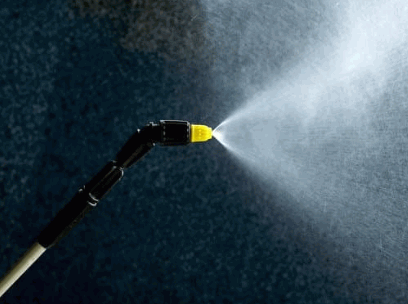
Selecting the right cleaning solution is crucial for effective cladding maintenance, as it plays a key role in stain removal and protecting the surface materials. Eco-friendly options, such as those containing sodium percarbonate, not only enhance cleaning efficiency but also minimize environmental impact, making them ideal for both residential and commercial applications.
When considering various cleaning agents, it is essential to evaluate their compatibility with different cladding materials such as aluminum, wood, and vinyl.
Understanding the specific needs of the cladding type will give the power to homeowners and property managers to choose a solution that balances efficacy with environmental responsibility.
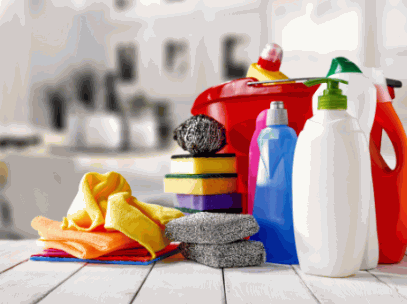
A soft bristle brush is a vital cleaning tool that ensures gentle yet effective maintenance of external cladding surfaces without risking damage, making it a key component of cladding cleaning.
Its design allows for careful maneuverability across various surfaces, including wood, vinyl, and fiber cement, which are commonly used in residential and commercial properties. Utilizing this tool regularly not only enhances the aesthetic appeal but also promotes longevity by safeguarding the material integrity against abrasive contaminants.
Incorporating the soft bristle brush, often part of a gentle wash approach, into a cleaning routine can significantly improve the resilience of cladding against the elements.
Incorporating this methodical approach to outdoor maintenance contributes to a healthier building environment and increases property value over time.

A ladder is often an essential cleaning tool when it comes to accessing higher areas of external cladding, ensuring that all surfaces are adequately maintained. It is crucial to prioritize health and safety by using a sturdy ladder and following proper protocols to prevent accidents during the cleaning process, ensuring that all areas are adequately covered.
In fact, the use of ladders not only facilitates effective cladding cleaning but also allows technicians to reach awkward angles and corners where debris can accumulate. A well-placed ladder can enhance productivity; however, it is essential to adopt safety practices to mitigate risks.
Here are some tips for safe ladder use, crucial for maintaining the high standard of cleaning:
By adhering to these guidelines, individuals can not only enhance their safety but also improve the efficiency of their cladding maintenance tasks.
Cleaning external cladding, including materials like uPVC Cladding, Composite Cladding, and Metal Cladding, is a systematic process that involves several steps to ensure thorough maintenance and preservation of the building's exterior.
By following a structured cleaning process, including preparation, application of the cleaning solution, and proper rinsing, homeowners and building contractors can effectively maintain the appearance and longevity of various cladding types, such as PVC Cladding and Composite Cladding, while preventing damage from dirt, moss, and organic growth.
Preparing the area for cladding cleaning is a critical first step that ensures both safety and effectiveness of the cleaning process. This includes removing any obstacles, covering nearby plants or furniture to protect them from cleaning solutions, and ensuring that the ground is stable for the ladder or pressure washer.
Before diving into the cleaning task, it is essential to consider several preparation steps that promote a smooth and secure experience.
Environmental considerations are paramount; using eco-friendly cleaning solutions not only safeguards the nearby flora and fauna but also contributes positively to overall sustainability efforts. Many professional cleaning companies advocate for eco-friendly solutions.
Ensuring that any runoff water is properly managed helps in maintaining the surrounding environment, making the entire process smoother and safer, especially considering the British weather and environmental pollution.
Mixing the appropriate cleaning solution, such as using DOFF Cleaning or sodium percarbonate, is vital for effectively tackling stains and organic growth like moss, algae, and lichen on external cladding. If using an eco-friendly cleaning agent, such as sodium percarbonate, it is essential to follow the manufacturer's instructions for dilution to ensure optimal cleaning results without damaging the surface. Ecoscape products are also highly recommended for their sustainability.
To create a successful mixture, start by measuring the sodium percarbonate, generally advised at a ratio of 1 part cleaner to 4 parts water for light stains. For tougher grime, a 1:3 ratio may deliver better efficacy. Adhering to these specified ratios is crucial to prevent surface harm while maximizing cleaning power. Always mix in a well-ventilated space, and wear protective gloves to avoid skin irritation.
Always test the solution on a small, inconspicuous area to verify compatibility before proceeding with full application.
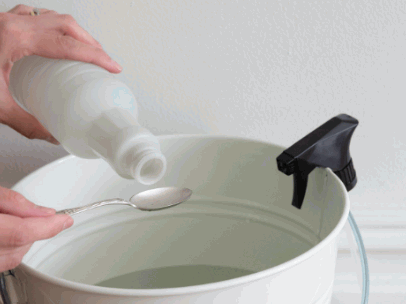
Before applying the cleaning solution, it is important to wet the cladding to loosen dirt and prepare the surface for effective cleaning.
This initial step helps to ensure that the cleaning solution adheres better and penetrates more deeply into grime and organic growth.
Wetting the cladding not only enhances the effectiveness of the cleaning process but also minimizes the risk of damaging the surface during scrubbing or pressure washing. By implementing a few simple techniques, individuals can optimize the cleaning procedure:
Ultimately, by carefully wetting the cladding and following best practices, such as using jet washing or biodegradable detergents, one can achieve a cleaner, brighter outcome.
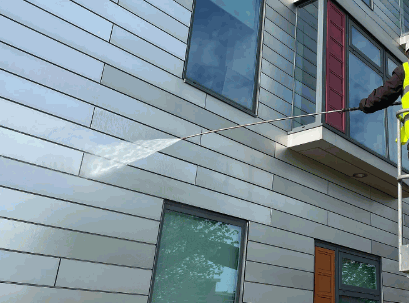
Applying the cleaning solution evenly across the cladding is a crucial step in the cleaning process, ensuring maximum effectiveness in removing dirt and organic growth. It is recommended to work from the bottom up to prevent streaking and allow the solution to penetrate effectively.
To achieve optimal results, one must focus on several application techniques designed for thorough coverage. Begin by preparing the area, ensuring that any loose debris is cleared away.
Once the solution is ready, consider using a:
Regardless of the method, it's essential to apply the solution in a consistent manner, allowing it to sit for the recommended duration to maximize its effectiveness. Timing is crucial—too short, and it won't clean effectively; too long, and it could damage surfaces. A rinse with fresh water afterwards will help to remove any residue, ensuring a clean finish.
Scrubbing the cladding with a soft bristle brush is a vital step that aids in removing stubborn stains and organic growth that are not eliminated by the cleaning solution alone.
Gentle scrubbing ensures that the surface is cleaned without causing damage to the cladding material.
Utilizing this technique not only enhances the effectiveness of the cleaning solution but also promotes the longevity of the cladding by preventing wear and tear that might result from harsher tools. The soft bristles penetrate the textures of the cladding, allowing for a thorough cleaning without scratching or harming the finish.
Here are some important techniques to consider:
This careful approach not only champions the integrity of the surface but also helps to maintain its aesthetic appeal for longer periods, ensuring the cladding material's long life. Following this process is essential for optimal care and upkeep, safeguarding against the impacts of environmental elements.
Rinsing the cladding thoroughly after scrubbing is essential to remove all traces of the cleaning solution and any remaining dirt or debris. Using a jet washer, pressure washer, or a garden hose, ensure that all surfaces are well rinsed to prevent any residue that could lead to discoloration or damage.
The rinsing process is not merely a matter of convenience; it is a crucial step in maintaining the appearance and longevity of the cladding. Effective rinsing techniques include:
Leaving any cleaning solution on the surface can lead to unwanted build-up, making regular maintenance more challenging. Therefore, a thorough rinse is not just important; it’s fundamental to preserving the integrity and look of the cladding over time.

Drying the cladding after cleaning, whether it is timber, concrete, or composite boards, is an important final step that helps to prevent water spots and ensures that the surface is ready for any subsequent maintenance or protective coating applications. It is ideal to allow the cladding to air dry naturally, but using clean towels can expedite the process if needed.
Proper drying techniques are crucial in preserving the aesthetic and functional integrity of cladding. Factors such as humidity, temperature, and airflow can greatly influence how effectively the drying occurs. For instance, in humid environments, a dehumidifier may be beneficial, while increased ventilation can aid in faster drying.
By ensuring that cladding is appropriately dried, one can significantly enhance its longevity and performance, while reducing the risk of future maintenance issues.
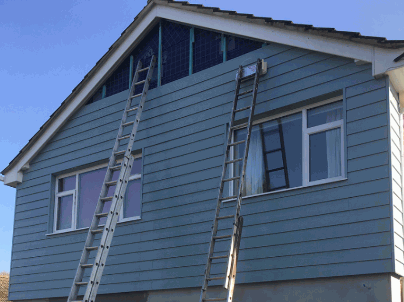
Determining how often to clean external cladding, including materials like uPVC cladding, is essential for maintaining its appearance and prolonging its lifespan, with several factors influencing the recommended frequency.
Considerations such as local weather conditions, the type of cladding materials like composite cladding or PVC cladding, and the surrounding environment can significantly affect how often a cleaning regimen should be implemented.
When deciding on the cleaning frequency for external cladding, several factors need to be taken into account, such as local environmental conditions, types of cladding materials, and the presence of organic growth like moss and algae. In areas with high levels of environmental pollution or frequent rain, more regular cleaning may be necessary to prevent damage and maintain appearance.
Understanding the nuances of these factors is essential for effective cladding maintenance.
For optimal maintenance, it is generally recommended to clean external cladding at least once or twice a year, depending on the factors discussed. In high-pollution areas or where trees may cause organic buildup, more frequent cleaning may be beneficial to prevent lasting damage and uphold the building's appearance. Consulting with a professional cleaning company can provide peace of mind and expert maintenance.
To devise a tailored cleaning schedule, it’s essential to consider environmental influences, the material of the cladding, and the overall weather patterns in your region. Collaborating with a building contractor can also ensure comprehensive scheduling. For instance:
Ultimately, adhering to a regular cleaning schedule not only preserves the aesthetic quality of the external facade but also enhances its durability, safeguarding the investment in the long run.
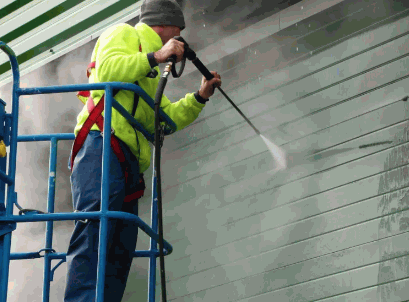
Along with regular cleaning, several maintenance tips can help ensure the longevity and appearance of external cladding, addressing issues such as weather damage and prevention of organic growth. Using eco-friendly products and methods, like DOFF cleaning and sodium percarbonate, can minimize environmental impact.
Incorporating routine inspections, timely repairs, and the application of protective coatings can significantly enhance the cladding's resilience and aesthetic appeal. Also, using a specialized cladding brush or soapy water for minor touch-ups can help maintain its look.